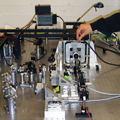Why motor proteins have brakes
Speedy couriers in the cell
20.05.2010, Press releases
Every single one of our cells contains so-called motor proteins that transport important substances from one location to another. However, very little is known about how exactly these transport processes occur. Biophysicists at the Technische Universitaet Muenchen (TUM) and Ludwig Maximilians Universitaet Muenchen (LMU) have now succeeded in explaining fundamental functions of a particularly interesting motor protein. They report their findings in the current issue of the Proceedings of the National Academy of Sciences (USA).
Motorized transport proteins are one of the keys to the development of higher organisms. It is they that enable the cell to transport important substances directly and quickly to a specific location in the cell. As bacteria cannot do this, they are not able to form larger cells or even large organisms with many cells. Particularly important are fast transport proteins in the primary cilia, the cell’s antennas, with which they channel information from the surroundings into the cell.
Like trucks on a highway, kinesins transport cellular loads to their destinations. They do this by crawling along protein fibers, so-called microtubules, which extend through the entire cell. Kinesins consist of two long intertwined protein chains. At one end of every protein there is a head that can attach itself to certain structures on the surface of the microtubules; the freight is attached to the other end.
Very special kinesins are at work in the cilia of the Caenorhabditis elegans nematode: they consist of two different protein chains and are therefore especially suitable for investigating the transport mechanisms. As freight, the researchers attached small plastic beads to the ends of these motor proteins. They can manipulate these beads with “optical tweezers," a specially formed laser beam.
One end of the protein molecule was held with the optical tweezers; the other was able to walk on microtubules. This enabled the scientists to measure the force with which the motor protein can pull. In this experimental setup, the kinesin-2 with its freight walks as far as 1,500 nanometers in tiny steps measuring a mere eight nanometers. “If we didn’t hold it back, it might still go a lot further,” says Zeynep Ökten from the Institute for Cell Biology at LMU.
The kinesin-2 investigated consists of one KLP11 and one KLP20 protein. By exchanging the heads of the chains, the researchers were able to show that KLP11 is a non-processive motor protein. It only becomes a transport protein in combination with KLP20. In further experiments they were able to explain why nature chooses this unusual combination: KLP20 proteins have no “brakes." A transport protein made of two KLP20 units would be permanently on the go and would waste energy. The KLP11, in contrast, has a mechanism called autoinhibition, which makes sure that the transport protein is at a standstill if no freight is attached.
“Our results show that a molecular motor must take on a large number of functions over and above simple transport, if it wants to operate successfully in a cell,” says Professor Matthias Rief from the Physics Department of the TU Muenchen. It must be possible to switch the motor on and off, and it must be able to accept a load needed at a specific location and hand it over at the destination. “It is impressive how nature manages to combine all of these functions in one molecule," Rief says. "In this respect it is still far superior to all the efforts of modern nanotechnology and serves as a great example to us all.”
This work was supported by funds from the Cluster of Excellence Center for Integrated Protein Science Munich (CIPSM), a Long Term European Molecular Biology Organization fellowship and grants from the Deutsche Forschungsgemeinschaft (DFG) and the Friedrich-Baur-Stiftung.
Original Publication:
Regulation of a heterodimeric kinesin-2 through an unprocessive motor domain that is turned processive by its partner,
Melanie Brunnbauer, Felix Mueller-Planitz, Süleyman Kösem, Thi-Hieu Hoa, Renate Dombi, J. Christof M. Gebhardt, Matthias Rief, and Zeynep Ökten
PNAS Early Edition, May 17, 2010 – http://www.pnas.org/cgi/doi/10.1073/pnas.1005177107
Pictures:
http://mediatum.ub.tum.de/?cunfold=979977&dir=979977&id=979977
Contact:
Prof. Matthias Rief
Chair for Experimental Physics (E 22)
Technische Universitaet Muenchen
James-Franck-Str. 1, 85748 Garching, Germany
Tel: +49 89 289 12471, Fax: +49 89 289 12523
E-mail
Kontakt: presse@tum.de
More Information
| 100520_MotorProtein_PW_DE.pdf |
Druckversion der Presseinformation (DE),
(Type: application/pdf,
Size: 175.3 kB)
Save attachment
|
|
| 100521_motorprotein_en_pw.pdf |
Printable version of the press release (EN),
(Type: application/x-download,
Size: 137.5 kB)
Save attachment
|




